This post may contain affiliate links. Please read our disclosure policy.
Make the best strawberry jam with this easy no-pectin strawberry jam recipe! It’s super fruity, made with just 3 ingredients, fresh or frozen berries, & can be refrigerated, frozen, or water bath canned!
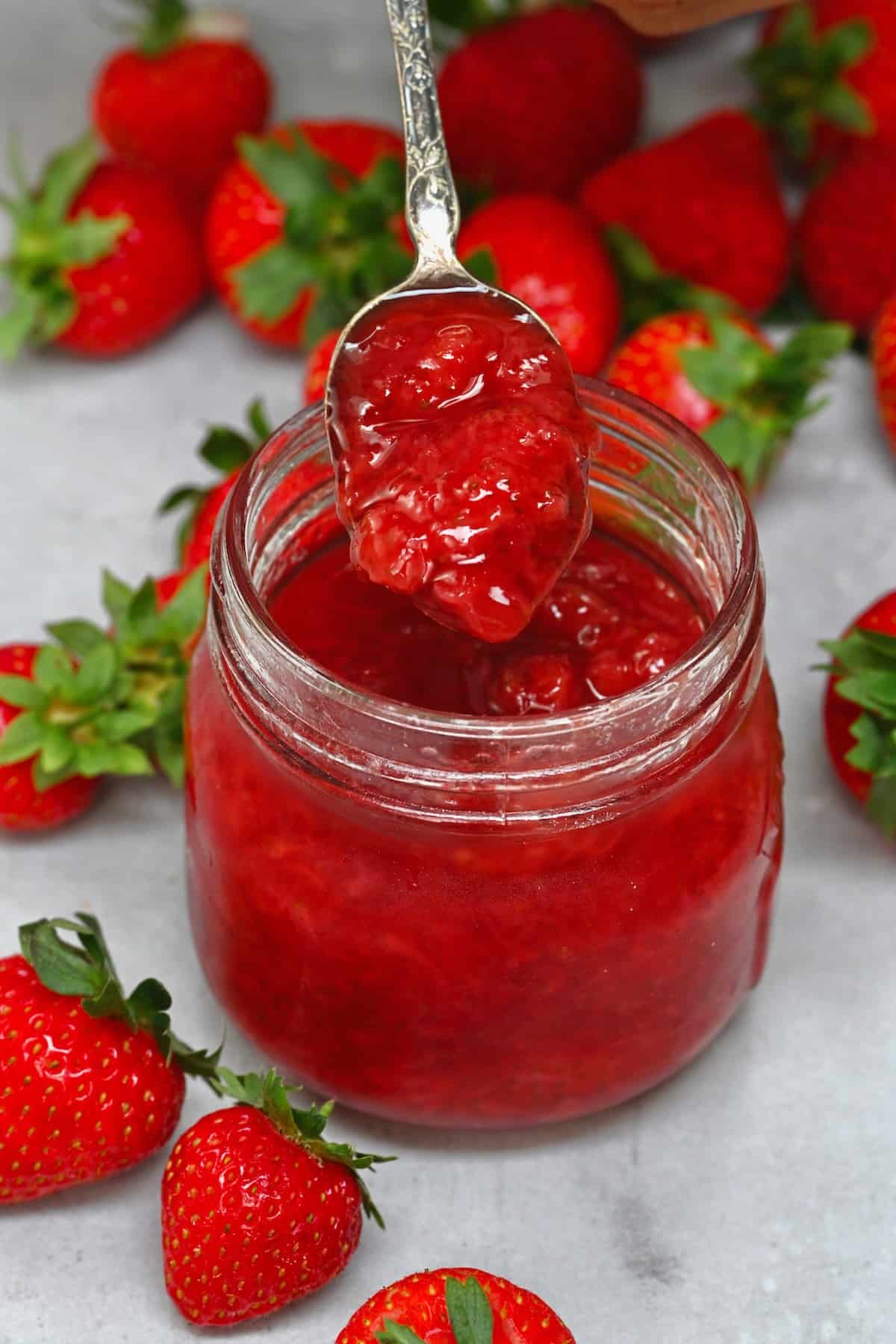
Have lots of strawberries to use? Making strawberry jam is a surprisingly simple, almost fool-proof process that can be ready in as little as 30 minutes with only strawberries, lemon, and sugar. This recipe uses beginner-friendly steps, so anyone can capture the taste of these summery berries for longer.
Unlike store-bought versions, my homemade strawberry jam requires less sugar, tastes much better and fresher, and is bursting with flavor. It’s also free from additives, preservatives, and thickeners (though you can flavor it if preferred – check the recipe card for inspiration!).
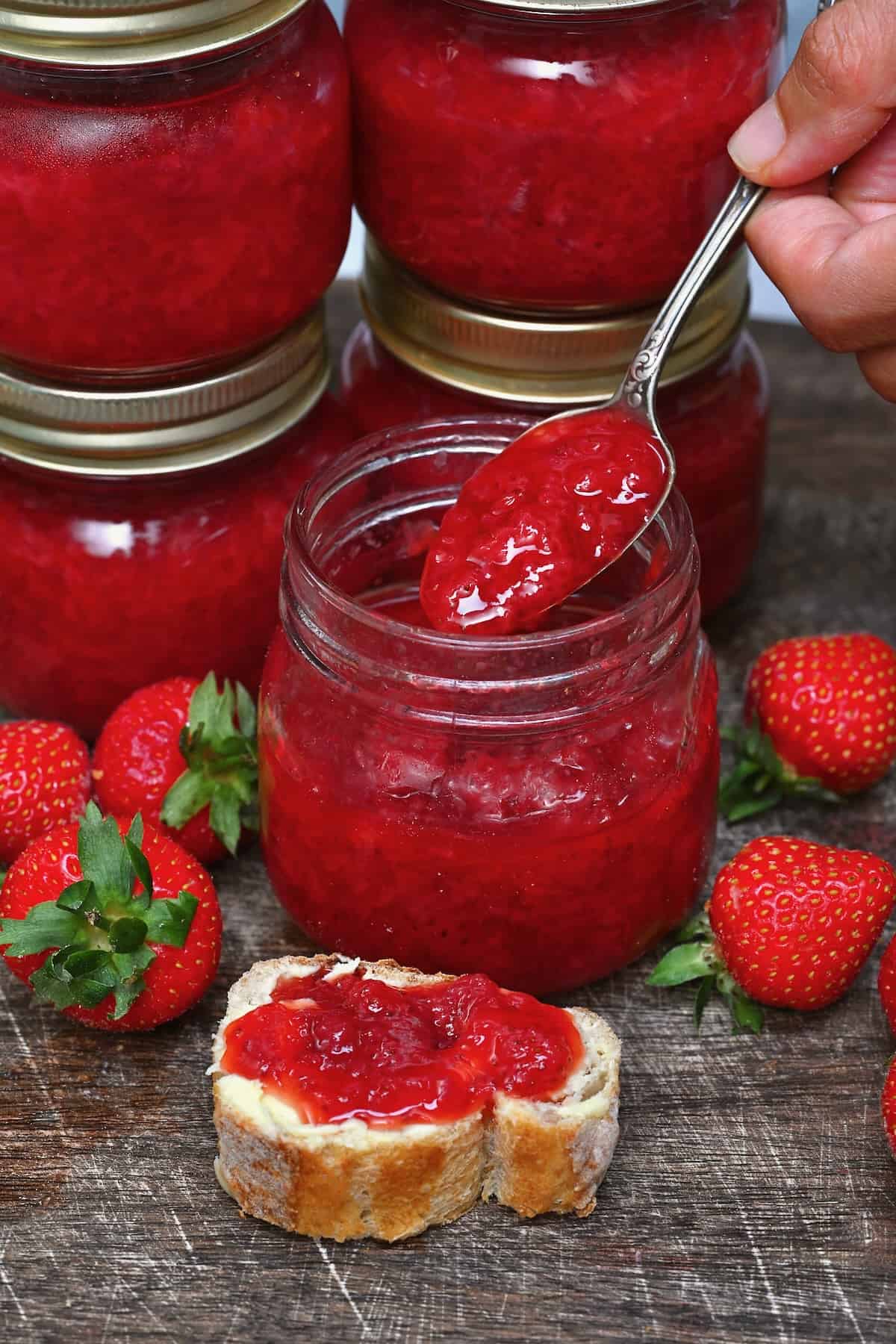
Want to save this recipe?
The Ingredients
- Strawberries: Slightly under-ripe fresh strawberries (some or all) work best to prepare a homemade jam that isn’t overly sweet. Frozen berries work, too, but they aren’t my preference.
- Sugar: Regular, granulated white sugar will provide the cleanest flavor, though you could experiment with brown sugar or use unrefined options (like coconut sugar).
It’s possible to use jam sugar, too, if that’s all you have, but jam sugar contains added pectin, so it will provide a harder set and cook quicker (up to 75% quicker). This strawberry jam no pectin recipe takes longer to cook before reaching the gel stage.
- Lemon: Use fresh or bottled lemon juice – the latter has a consistent pH (unlike fresh lemons) and is better for canning. The pH levels in lemon work as a sort of “bond” to bring the pectin together in the jam mixture and allow it to set. It also helps prevent the growth of bacteria. I use lemon zest, too, for more flavor.
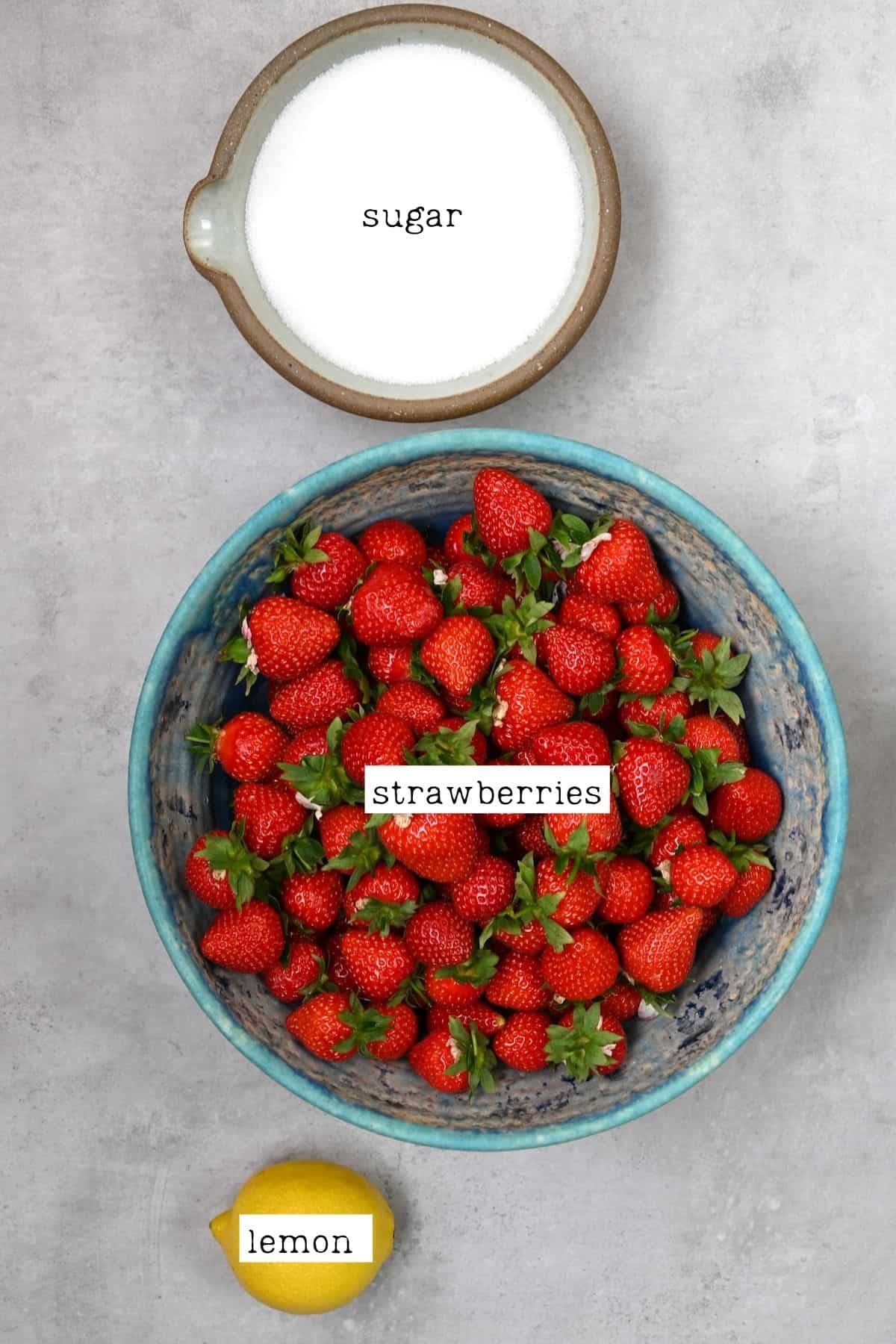
How to Make Strawberry Jam Without Pectin
First, sterilize the jars/tools – i.e., non-reactive saucepan, spoon, etc.- in hot, soapy liquid. Or do so in the dishwasher, ensuring they’re still hot when you use them. Then leave them to drain and dry on a clean, sterilized surface.
If you don’t have a thermometer, place 2-3 small plates in the freezer for the gel test.
To water bath can the jam, prepare the canner now by adding a trivet/rack and filling it with enough water to submerge the jars by an inch. If you didn’t use the dishwasher to keep the jars hot, place the lidded jars in the water and heat the water to an almost boil while preparing the jam.
Prepare the Ingredients
Wash the strawberries well, then use a small knife (or a straw pushed through the bottom) to remove the stems and leaves. Remove any berries that are blemished/spoiled.
Also, zest, then juice the lemon.
Optionally keep a few of the lemon seeds, too, as they’re packed with pectin and can be fished out of the jam before storing/canning it.
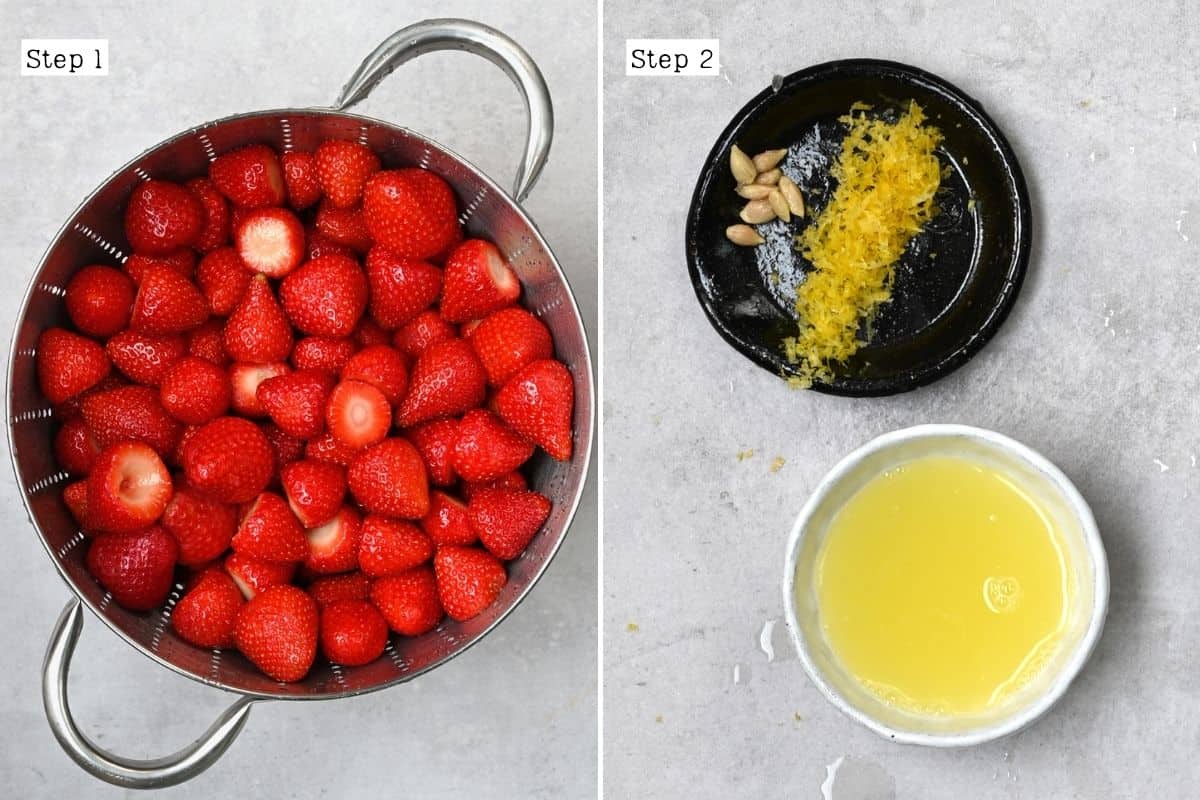
Cook the Jam
Transfer the strawberries and sugar to a large, deep, heavy-based stainless-steel saucepan and use a potato masher to mash them into a pulp (or your desired consistency).
Add the lemon juice and zest (and seeds, if using), and stir. Bring the mixture to a full rolling boil over medium-low heat, stirring constantly to ensure the sugar dissolves, and the jam doesn’t scorch to the bottom of the pan.
Skim any foam that appears (to avoid cloudy jam), simmering until it thickens enough to coat the back of a spoon. This takes about 15-20 minutes for this small batch.

The Gel Test
Remove the jam from the heat before testing its set. Then, if you have a thermometer, use it to test that the jam has reached 220ºF/104ºC.
If not, add a spoonful of jam to one of the freezer plates and return it to the freezer for a minute before testing. It should be set and wrinkle when pressed on the edges.
If it hasn’t set, continue to cook the jam for a few minutes and test it again.
Prepare and Fill the Jars
Place the sterilized, hot jars on a clean kitchen towel/wooden board (to avoid them cracking). Carefully pour/spoon the jam (using a jarring funnel helps avoid mess) into the jars, leaving ¼-inch headspace (0.5 cm) at the top.
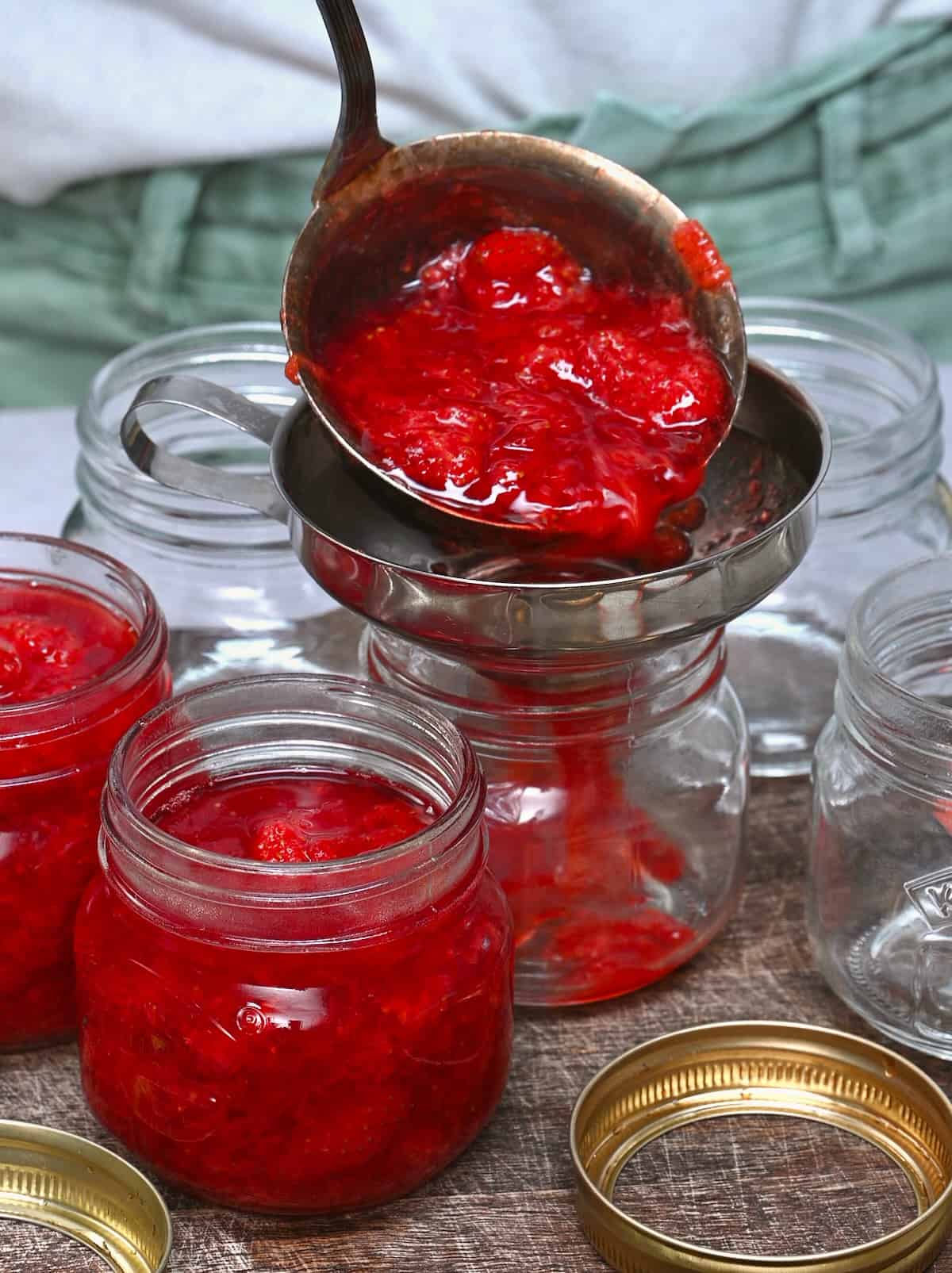
Wipe the jar rims with a clean kitchen towel and place the lid on the jar, screwing the screw bands until resistance is met, then increase to fingertip-tight.
If you aren’t canning, your homemade jam is now ready to cool slightly, then refrigerate.
Water Bath Canning
Place the filled jars in the prepared canner, ensuring they’re submerged under at least 1 inch of water. Then, bring the water to a boil over medium-high heat, add a lid, and allow them to process for 10 minutes (adjust the time based on your altitude).
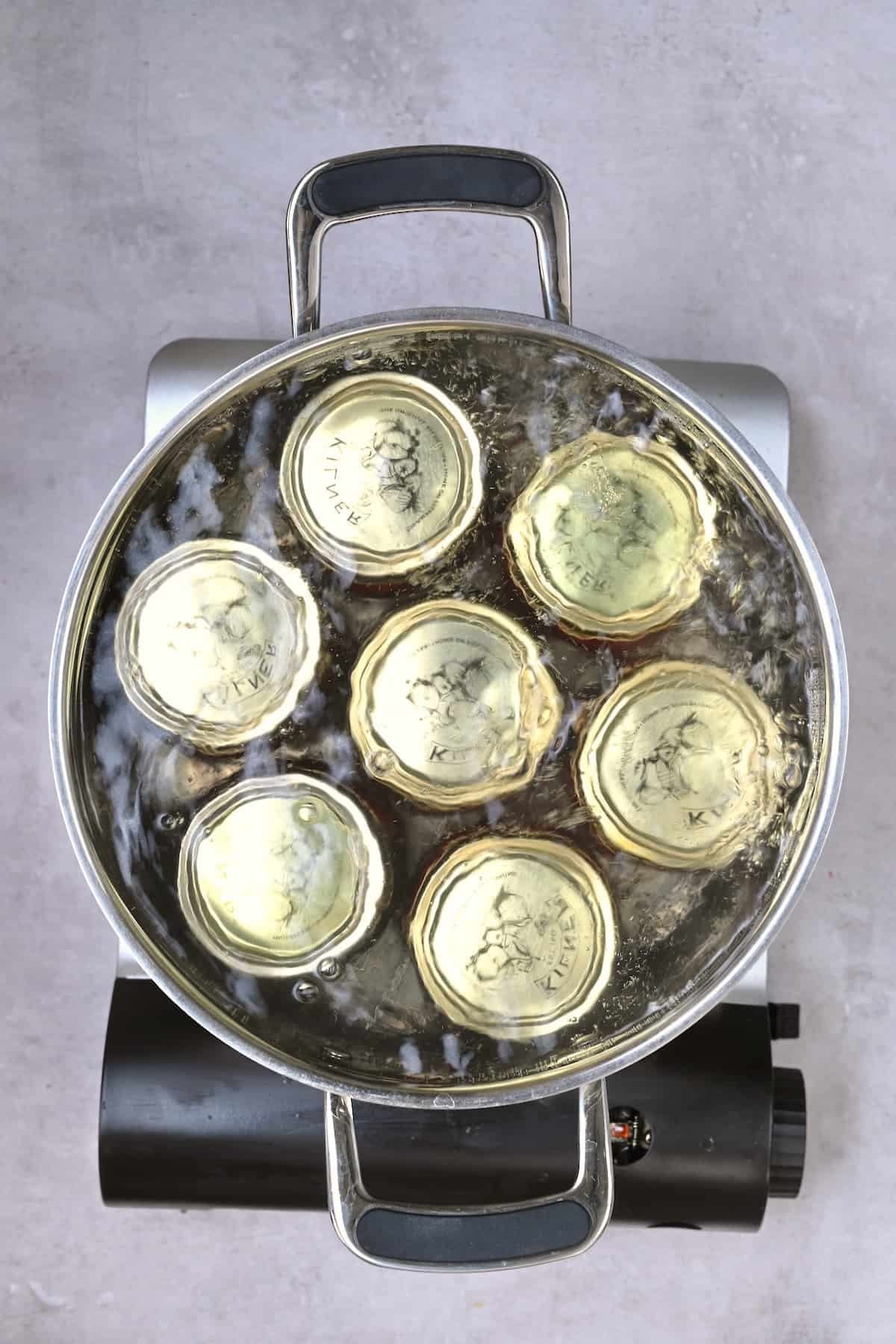
Remove the water bath canner lid and allow the jars to sit for 5 minutes before using canning jar tongs to transfer them to a clean kitchen towel (to avoid cracking) an inch or two apart to cool undisturbed for 24 hours.
Once cooled, check the jar seals – remove the screw band, and the lid should stay in place. Then store them in a cool, dark location (like your pantry) for up to a year and a half.
Re-process any unsealed jars with new lids/jars (after checking for chips) or transfer them to the fridge to use within a month.
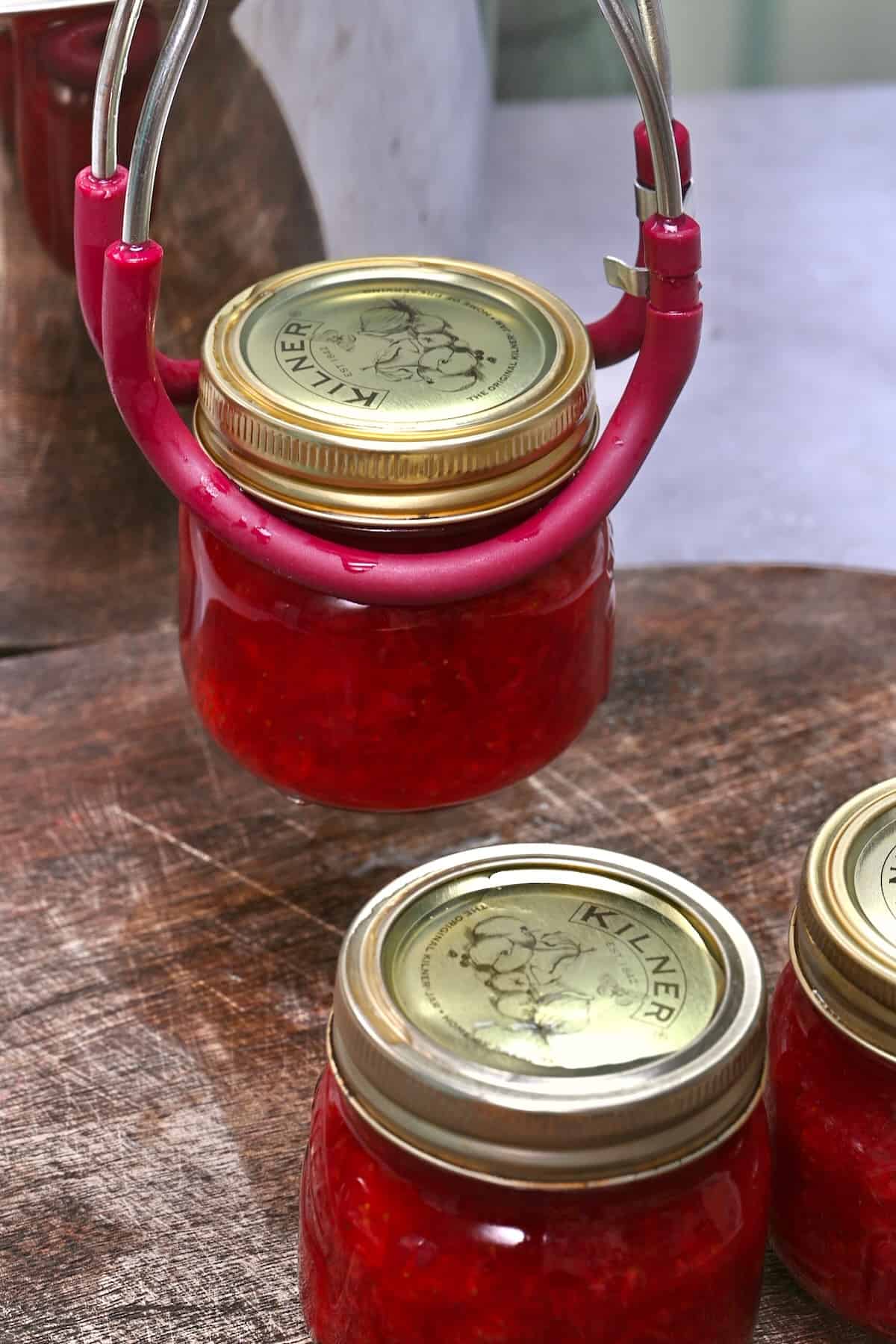
How to Store
If you haven’t water bath canned the homemade jam, aim to use it within 2-3 weeks in the refrigerator or 4-6 months in the freezer.
Canning jam makes it shelf-stable to store in a cool, dark pantry/kitchen cupboard for 12 months. Once opened, transfer the jar to the fridge to use within a month.
Top Tips for Success
- The best strawberries: Slightly under-ripe berries work best for delicious jam that’s not overly sweet.
- Make sure to use sterilized jars: This is important to avoid premature spoiling.
- For the best flavor: Macerate the strawberries and sugar for a few hours (or overnight) first. This pulls out juices from the fruit to create a syrup, releasing more flavor and reducing cooking time.
- Stir constantly: To avoid it scorching and sticking to the bottom of the saucepan.
- Mix the berries: Feel free to use a combination (i.e., blueberries, raspberries, blackberries). Adjust the cooking time accordingly, as the pectin levels vary.
- The sugar content: Reduced sugar in a jam recipe means a shorter shelf life and thinner set. Low-sugar/sugar-free strawberry jam, for instance, requires added pectin.
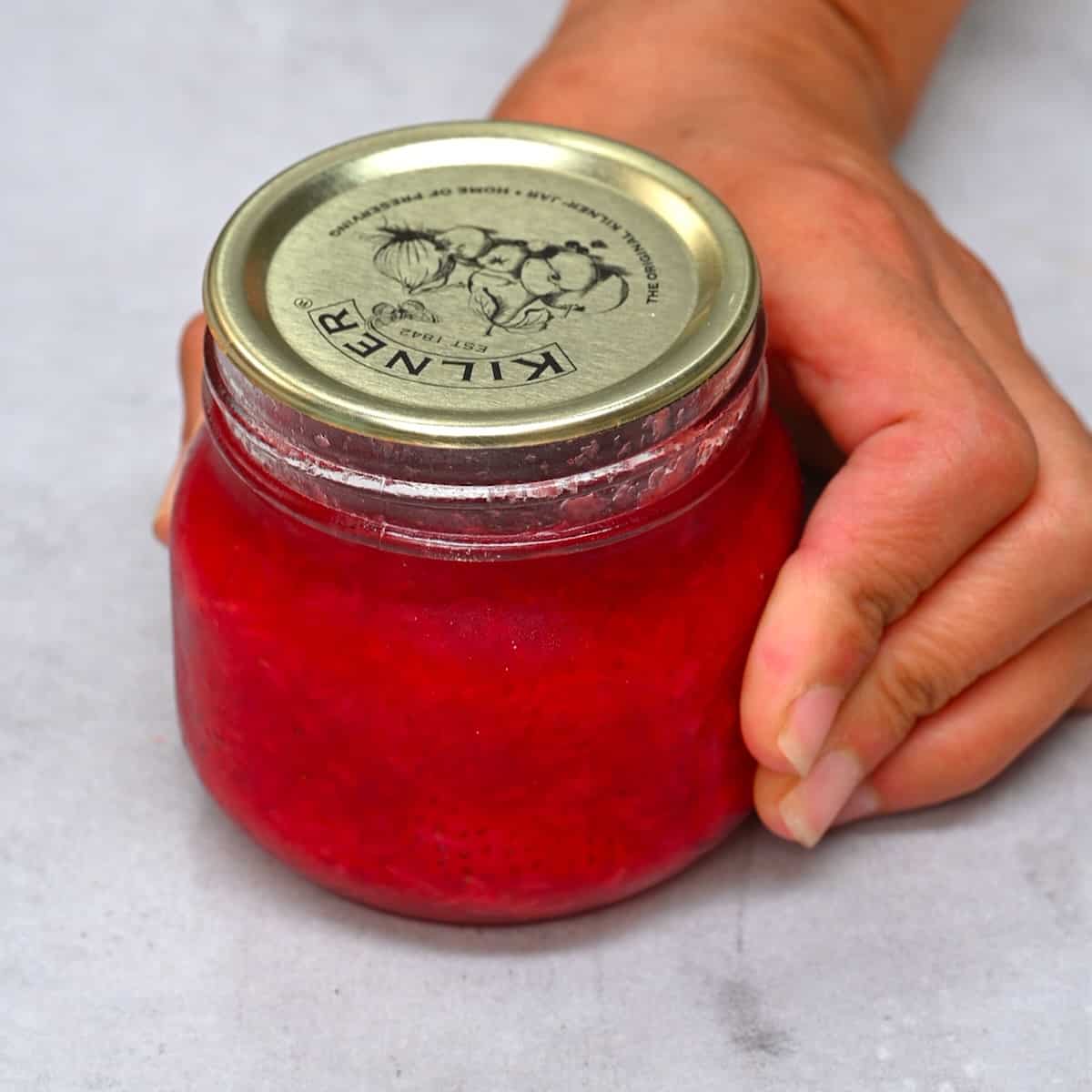
How to Serve
You can use strawberry jam in all the same ways you would other fruity jams. I.e., spreading over toast/bagels, over pancakes, croissants, French toast, and banana bread, with overnight oats, chia pudding, rice pudding, or yogurt, and to make a classic peanut butter and jelly sandwich or grilled cheese.
You can also use it with vanilla ice cream or to spread/fill baked goods, too, like a Swiss roll, layer cake, cupcakes, thumbprint cookies, and more. It makes a great gift, too.
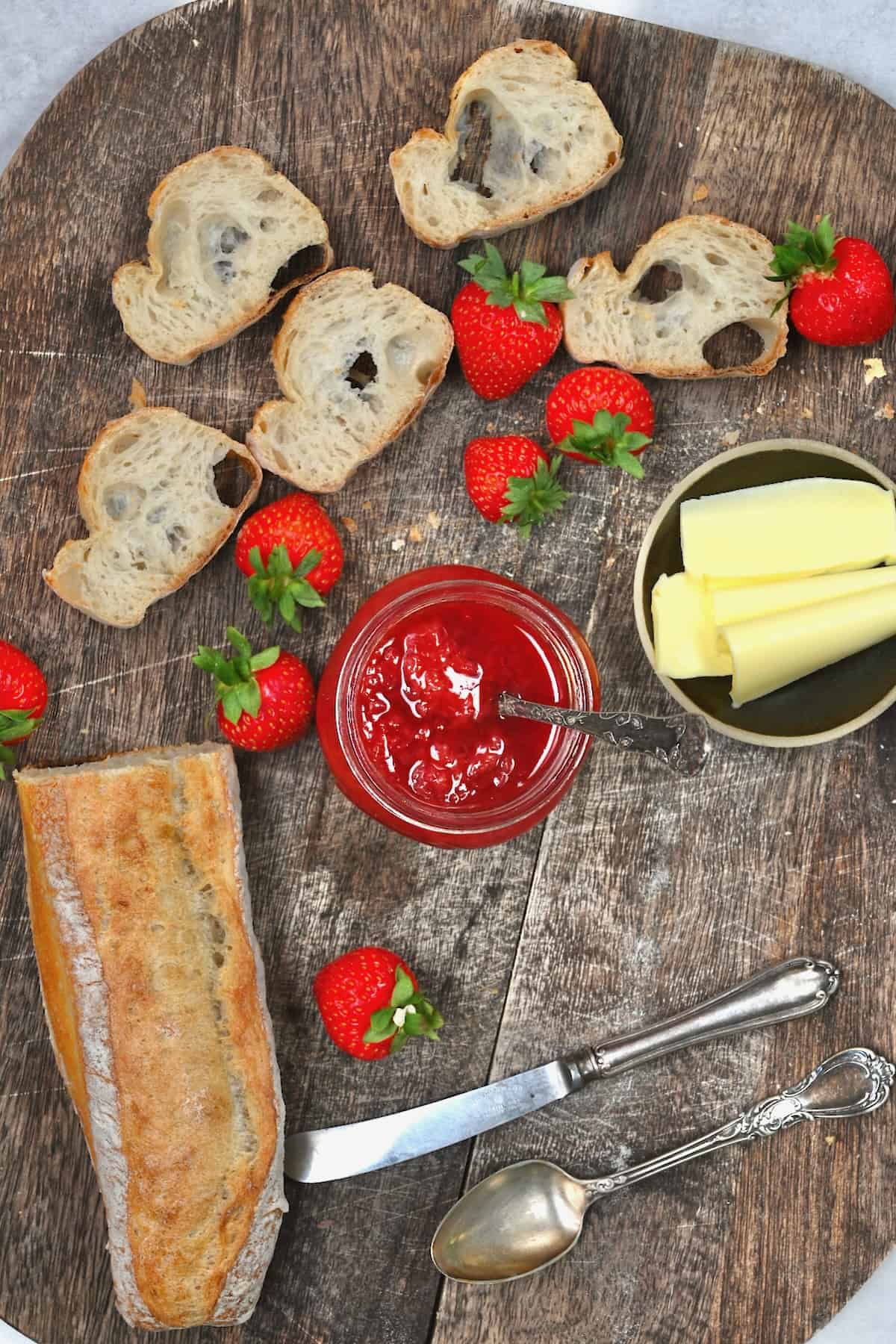
More Homemade Jam Recipes
If you try this easy strawberry jam recipe, let me know how it goes in the comments below. I’d appreciate a recipe card rating and would love to see your recipe recreations – tag me on Instagram @Alphafoodie!
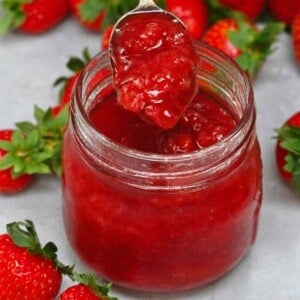
Easy Homemade Strawberry Jam (No Pectin)
Equipment
- 7 Glass jars 8 oz each (250 ml)
- Large, shallow heavy-based saucepan
- Silicone spatula or wooden spoon
- Potato masher or another similar tool
- Sieve or jelly bag optional
- Bubble remover optional
- Magnetic lid wand optional
Ingredients
- 3.5 lb strawberries slightly underripe work best; though you can use fresh or frozen
- 1.16 lb white sugar 2¾ cups; or experiment with brown sugar, coconut sugar, etc.
- 1/3 cup lemon juice
- 1 Tbsp lemon zest from 1 lemon
- 6-7 lemon seeds optional, they are high in pectin
Instructions
Prepare the tools
- Sterilize the jars/tools – i.e., non-reactive saucepan, spoon, etc.- in hot, soapy liquid. Or do so in the dishwasher, ensuring they're still hot when you use them. Then leave them to drain and dry on a clean, sterilized surface.
- If you don't have a thermometer, place 2-3 small plates in the freezer for the gel test.
- If you're planning to water bath can the jam, prepare the canner by adding a trivet/rack and filling it with enough water to submerge the jars by an inch. If you didn’t use the dishwasher to keep the jars hot, place the lidded jars in the water and heat the water to an almost boil while preparing the jam.
Prepare the berries
- Wash the strawberries well, then use a small knife (or a straw pushed through the bottom) to remove the stems and leaves. Remove any berries that are blemished/spoiled.
- Zest and juice the lemon. Optionally keep a few of the lemon seeds, too, as they're packed with pectin and can be fished out of the jam before storing/canning it.
Make the jam
- Transfer the strawberries and sugar to a large, deep, heavy-based stainless-steel saucepan and use a potato masher to mash them into a pulp (or your desired consistency).
- Add the lemon juice and zest (and seeds, if using), and stir. Bring the mixture to a boil over medium-low heat, stirring constantly to ensure the sugar dissolves, and the jam doesn’t scorch to the bottom of the pan.
- Skim any foam that appears (to avoid cloudy jam), simmering until it thickens enough to coat the back of a spoon. This usually takes about 15-20 minutes.
The gel test
- Remove the jam from the heat before testing its set. Then, if you have a thermometer, use it to test that the jam has reached 220ºF/104ºC.If not, add a spoonful of jam to one of the freezer plates and return it to the freezer for a minute before testing. It should be set and wrinkle when pressed on the edges. If it hasn’t set, continue to cook the jam for a few minutes and test it again.
Fill the jars
- Place the sterilized, hot jars on a clean kitchen towel/wooden board (to avoid them cracking) and carefully pour/spoon the jam (using a jarring funnel helps avoid mess) into the jars, leaving ¼-inch headspace (0.5 cm) at the top.
- Wipe the jar rims with a clean kitchen towel and place the lid on the jar, screwing the screw bands until resistance is met, then increase to fingertip-tight.If you aren't canning, your homemade jam is now ready to cool, then refrigerate.
Water bath canning
- Place the filled jars in the prepared canner, ensuring they're submerged under at least 1 inch of water. Bring the water to a boil over medium-high heat, add a lid, and allow them to process for 10 minutes (adjust the time based on your altitude).
- Remove the canner lid and allow them to sit for 5 minutes before using canning jar tongs to transfer the jars to a clean kitchen towel (to avoid cracking) an inch or two apart to cool undisturbed for 24 hours.
- Once cooled, check the jar seals (remove the screw band, and the lid should stay in place), then store them in a cool, dark location (like your pantry) for up to a year and a half.Re-process any unsealed jars with new lids/jars (after checking for chips) or transfer them to the fridge to use within a month.
Video
Notes
- Vanilla: Add pure vanilla extract (or paste) at the end (off heat).
- Almond extract: Stir it in off the heat at the end for a subtle nutty flavor.
- Orange: Use orange zest instead of lemon for a bright, citrusy flavor.
- Spices: You can experiment with cinnamon, nutmeg, pumpkin pie spice, etc. Add it to taste.
- Fresh herbs: I.e., a handful of finely chopped mint, thyme, rosemary, or basil.
- Ginger: Add finely grated ginger to taste, starting with about ½ teaspoon.
- Chili: i.e., strawberry jalapeño jam/strawberry habanero jam. Finely dice the chili and remove the seeds. Add as much as you’d like for a subtle or big kick.
- Maple syrup/ honey: Add just a small amount instead of regular sugar for subtle flavor depth without overwhelming the strawberry flavor.
- Balsamic vinegar: A splash adds a wonderful tangy depth.
- Alcohol: Add a splash of Amaretto, bourbon, or orange liqueur to create a more complex, full-bodied jam.
Nutrition
Nutrition information is automatically calculated, so should only be used as an approximation.

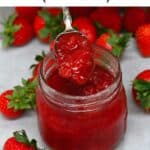
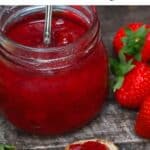
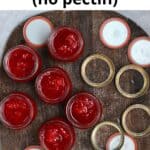









Just made a batch of this yesterday and it came out fantastic. The flavor is so good. I wanted the consistency to gel a little more but I could never get the temperature above 115 degrees for some reason. Can you offer any insight on this. Thank you so much and thanks for sharing such a wonderful recipe.
Hi Patricia,
Glad you liked it. To get the consistency to get, it’s important to reach a temperature of about 220ºF/104ºC. Simmering at medium-high to high can help, as long as the jam doesn’t scorch in the saucepan. Also, adding a bit more lemon zest or the lemon pits can help bring more pectin to the strawberries and help the jam gel.
Excellent jam
Thank you for your lovely comment Deborah. 🙂